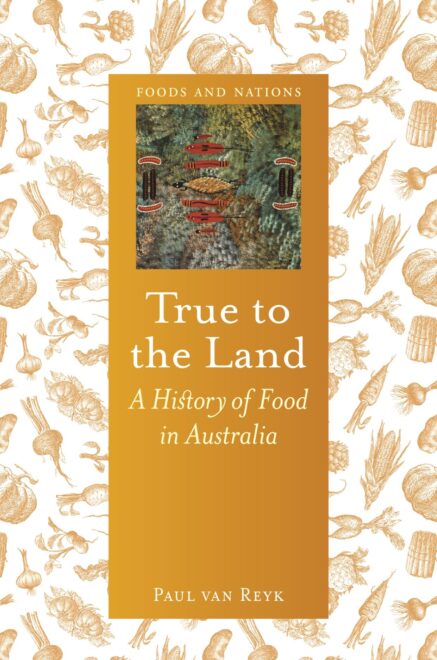 As editor of both Australian Garden History and the Professional Historians Association’s review page, I receive advice about a lot of books, some of which I think will interest members of both organisations. True to the Land: a history of food in Australia by Paul van Reyk (Reaktion Books, 2021) is one of those. Jacqui Newling kindly agreed to do a review for each audience.
As editor of both Australian Garden History and the Professional Historians Association’s review page, I receive advice about a lot of books, some of which I think will interest members of both organisations. True to the Land: a history of food in Australia by Paul van Reyk (Reaktion Books, 2021) is one of those. Jacqui Newling kindly agreed to do a review for each audience.
True to the land joins Reaktion’s Foods and Nations series, which aims to apply a historical and geographical lens to ‘how food production and consumption of food developed, and how they were influenced by the culinary practices of other places and peoples’. Van Reyk meets this criteria admirably, earning endorsement from Professor Emeritus Barbara Santich – arguably Australia’s leading voice in academic food studies – as ‘a masterful overview of Australian food and foodways’.
Aimed at a broad readership, this book is no romp through the tantalising delights and clichéd curiosities of ‘slippery bob’, ‘kangaroo steamer’ and the like, and it contains only a few recipes. Van Reyk’s voice is direct but relatively informal, his pacing lively but unrushed, but True to the land is a serious and well researched study; fully indexed and referenced. Arranged chronologically over 10 chapters, and supported by contemporary and historical images, it recounts ‘the 60,000-year history of food [and drink] in Australia’ – no mean feat for 250 pages.
The explanation of the Commonwealth of Australia in the early pages indicates that this book is written for international readership (though some domestic readers may be unaware of the nation’s island territories). Strong emphasis is placed on climate and environmental conditions, agriculture, technological and industrial innovation (and mistakes), government economic and social policies – land and water management, global economic relationships, food equity and sovereignty, and racially prejudiced migration are core themes. Men dominate many of these fields, but women are duly credited in the development and dissemination of taste and culinary practice as domestic cooks, chefs and restaurateurs, writers, educators and activists for social change. There is a pleasing focus on more convivial cultural practices and social trends, with voices from the ‘ground up’, through historical memoirs and anecdotes in the media and popular culture.
The first chapter is dedicated to the land itself, its geology, topography, climate and waterways. Australia’s First People and their traditional cultures are the subject of the second chapter. Here the author discusses their land management approaches and food practices developed over millennia, including a short section on Torres Strait Islander foodways. First Nations peoples maintain an important presence throughout subsequent chapters, which move through the transfer, and adaptation of, British tastes in the colonies; the shaping and impacts of ‘White Australia’ at Federation and in the interwar and post-Second World War periods; and the increasing globalisation of taste in the Baby Boomer-dominated.
We are not limited to metropolitan history, with the inclusion of outback farming and stock-routes, the role of camel-trains and paddle-steamers in transporting food to and from inland areas, and the exploitation of Indigenous and immigrant workers. Diving into Australian drinking culture encompasses the colonial rum and temperance movements, the gradual acceptance of wine, the school milk program and the lockout laws of the 2010s. Breakout sections profile select incidents, innovations and personalities, as well as the odd recipe or food item, however at times, their placement interferes with the principal narrative flow. The final chapter is a ‘reckoning’ in the midst of climate crises, calling for investment in sustainable food production and management of lands and waters through regenerative and agroecological farming, including native crops, with active involvement with and benefits for Indigenous communities.
Van Reyk deserves credit for bringing to the fore many of the actors, events and circumstances less visible in popular commentaries, and the overtly socio-political focus distinguishes True to the land from many other food histories. Some casual ‘foodies’ may wonder how some issues raised are relevant to food, but as the book unfolds, these are revealed as oft-hidden ingredients in the grand scheme of the meal. Small errors – mainly dates – do the book a disservice, but True to the land is well worth the attention of those interested in Australian gastronomic history in its many guises – political, economic, cultural and environmental – and how these entities now shape our food future.
Reviewer, Jacqui Newling, gastronomer and historian

